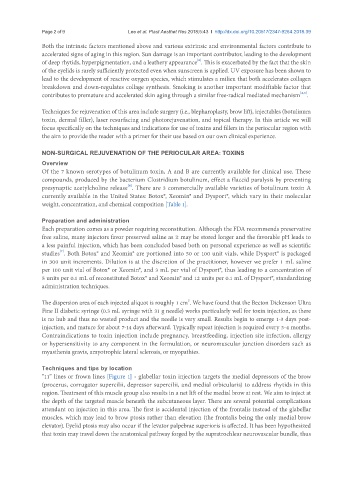Page 316 - Read Online
P. 316
Page 2 of 9 Lee et al. Plast Aesthet Res 2018;5:43 I http://dx.doi.org/10.20517/2347-9264.2018.39
Both the intrinsic factors mentioned above and various extrinsic and environmental factors contribute to
accelerated signs of aging in this region. Sun damage is an important contributor, leading to the development
[2]
of deep rhytids, hyperpigmentation, and a leathery appearance . This is exacerbated by the fact that the skin
of the eyelids is rarely sufficiently protected even when sunscreen is applied. UV exposure has been shown to
lead to the development of reactive oxygen species, which stimulates a milieu that both accelerates collagen
breakdown and down-regulates collage synthesis. Smoking is another important modifiable factor that
[4,5]
contributes to premature and accelerated skin aging through a similar free-radical mediated mechanism .
Techniques for rejuvenation of this area include surgery (i.e., blepharoplasty, brow lift), injectables (botulinum
toxin, dermal filler), laser resurfacing and photorejuvenation, and topical therapy. In this article we will
focus specifically on the techniques and indications for use of toxins and fillers in the periocular region with
the aim to provide the reader with a primer for their use based on our own clinical experience.
NON-SURGICAL REJUVENATION OF THE PERIOCULAR AREA: TOXINS
Overview
Of the 7 known serotypes of botulinum toxin, A and B are currently available for clinical use. These
compounds, produced by the bacterium Clostridium botulinum, effect a flaccid paralysis by preventing
[6]
presynaptic acetylcholine release . There are 3 commercially available varieties of botulinum toxin A
currently available in the United States: Botox®, Xeomin® and Dysport®, which vary in their molecular
weight, concentration, and chemical composition [Table 1].
Preparation and administration
Each preparation comes as a powder requiring reconstitution. Although the FDA recommends preservative
free saline, many injectors favor preserved saline as it may be stored longer and the favorable pH leads to
a less painful injection, which has been concluded based both on personal experience as well as scientific
[7]
studies . Both Botox® and Xeomin® are portioned into 50 or 100 unit vials, while Dysport® is packaged
in 300 unit increments. Dilution is at the discretion of the practitioner, however we prefer 1 mL saline
per 100 unit vial of Botox® or Xeomin®, and 3 mL per vial of Dysport®, thus leading to a concentration of
5 units per 0.1 mL of reconstituted Botox® and Xeomin® and 12 units per 0.1 mL of Dysport®, standardizing
administration techniques.
2
The dispersion area of each injected aliquot is roughly 1 cm . We have found that the Becton Dickenson Ultra
Fine II diabetic syringe (0.3 mL syringe with 31 g needle) works particularly well for toxin injection, as there
is no hub and thus no wasted product and the needle is very small. Results begin to emerge 1-3 days post-
injection, and mature for about 7-14 days afterward. Typically repeat injection is required every 3-4 months.
Contraindications to toxin injection include pregnancy, breastfeeding, injection site infection, allergy
or hypersensitivity to any component in the formulation, or neuromuscular junction disorders such as
myasthenia gravis, amyotrophic lateral sclerosis, or myopathies.
Techniques and tips by location
“11” lines or frown lines [Figure 1] - glabellar toxin injection targets the medial depressors of the brow
(procerus, corrugator supercilii, depressor supercilii, and medial orbicularis) to address rhytids in this
region. Treatment of this muscle group also results in a net lift of the medial brow at rest. We aim to inject at
the depth of the targeted muscle beneath the subcutaneous layer. There are several potential complications
attendant on injection in this area. The first is accidental injection of the frontalis instead of the glabellar
muscles, which may lead to brow ptosis rather than elevation (the frontalis being the only medial brow
elevator). Eyelid ptosis may also occur if the levator palpebrae superioris is affected. It has been hypothesized
that toxin may travel down the anatomical pathway forged by the supratrochlear neurovascular bundle, thus

